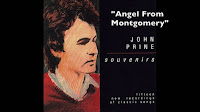 |
| Fleetwood Pennsylvania |
 |
| Dennis Fano |
This town was the home of luthier Dennis Fano, who built some exquisite and original guitars there under the brand name Fano Guitars, and then under another brand name Novo Guitars.
He sold Fano guitars to a company called Premier Builder Guitars, which eventually was acquired by Desert Son Musical Instruments. This company currently builds Fano Guitars in the much warmer climate of Scottsdale, Arizona. The story of how Desert Son Musical Instruments is somewhat convoluted, as I will explain.
 |
| Walter Becker's Fano Alt de Facto GF6 |
I first ran across the Fano brand when researching an article about the passing of Walter Becker, and the unique guitars that he used. One of the guitars he owned was a Fano Alt de Facto which had twin Lindy Fralin P90 style pickups and a ‘Tone Styler’ control.
 |
| Matt Umanov Guitars |
When Dennis first opened his Pennsylvania shop, Fano Guitars, he repaired and modified bass guitars, with one of the first models Fano modified were his Fender Jazz Bass and then a Harmony bass. Since those day Dennis Fano acquired a reputation for building boutique guitars. His flagship model was the aforementioned Alt de Facto guitar line-up which is available in a wide range of styles and options.
 |
| 2010 Fano Alt De Facto JM6 |
Dennis built up Fano Guitars until 2009, when he sold the company to Premier Builders Guild aka PBG. Dennis Fano then became an employee of that company, working at his old workshop and doing prototypes and one-offs. He worked there until 2014 when he started his current brand Novo Guitars.
 |
| Gene Baker B3 Guitars |
PBG Fano Guitars also purchased boutique builder Gene Baker's "B3" guitars and set up shop in Arroyo Grande California.
 |
| Koll Guitars |
Saul Koll was another builder associated with PBG. He left PBG in 2015 and returned to running his company, Koll Guitars in Los Angeles, California.
In 2015 Gene Baker took back his B3 brand from PBG and resumes building his own boutique guitars.
That same year PBG shut down the Arroyo Grand facility and farmed out building Fano Guitars to Grover Jackson's company. The company, still known as Fano Guitars, began offering the Fano Standard Series, which utilized necks and bodies possibly made in Japan. However the Alt de Facto series was always made in the USA.
 |
| Jack Schwartz - Fano Guitars |
At the end of 2016 PBG (Premier Builders Guild) made a decision to sell out to Desert Son Music, which was headed up by Jack Schwarz, who spent many years working for Fender Musical Instruments.
 |
| Desert Son Musical Instruments - Fano Guitars |
 |
| Dennis Fano at work |
Dennis Fano is currently building his own models under the Novo Guitar brand. He once again moved his shop. This time to Nashville, Tennessee. He hired Matthew Timmons, formerly of Lollar pickups as the shop's general manager.
 |
| A Few Fano Models |
The Novo Serus line up consists of six different models. These have familiar features from popular guitars such as the Telecaster, Jazzmaster, and Strat, but with a different shape. The design favors the offset-body style like the Jazzmaster, but with sharper on the horns.
All feature Fralin pickups, or Lollar pickups and Mastery bridges (from The Mastery Bridge Company).
 |
| Novo Serus J |
The also utilize Emerson potentiometers and Emerson paper in oil capacitors of varying types.
For the Serus J-Series, think Jazzmaster, but without the second circuit.
 |
| Novo Serues JS |
The Serus JS-Series is a similar guitar, but without the vibrato bar.
 |
| Novo Serus S |
The Serus S-series comes with three Fralin single coil strat-like pickups and the vibrato,
 |
| Novo Serus SV |
 |
| Novo Serus T |
As with all Novo guitars, this model comes standard with a pine body, but you can customize it with different wood, and other options.
 |
| Novo Serus TC |
The Novo Miris Series is made up of two guitars. The standard body is pine, but as with all Novo models you can customize to a different wood material.
 |
| Novo Miris J |
The Miris J is done in the Fender Thinline Telecaster style, with a single 'F' hole, but in the Novo shape. The large pickguard in made of chrome/nickel, and topped with two Fralin Alnico hum-cancelling P-90 pickups.
The guitars top is trimmed in herringbone. This model has a Jazzmaster style vibrato, and strat-style knobs.
 |
| Novo Miris T |
The two models that make up the Novo Solus Series sport a different shape. This series feature more of a single pickup Les Paul Standard type guitar.
 |
| Novo Solus F1 |
The Solus F1 has a chrome/nickel Tele-style bridge plate with the three piece brass adjustable saddle unit, topped with a Fralin T style pickup. The neck scale on this guitar is 24.75" compared to 25.5" on other Novo models.
 |
| Novo Solus M1 |
 |
| Eastwood Rivolta Guitars |
The more affordable Eastwood Rivolta line was designed by Dennis Fano, and built by Eastwood Guitars. Their guitars are built in China and South Korea. This line up consists of 14 different guitars, a baritone guitar, and a bass guitar, ranging in price $900 to $1400 USD.
Click on the links under the pictures for sources. Click on the links in the text for further information.
©UniqueGuitar Publications 2020 (text only)











































